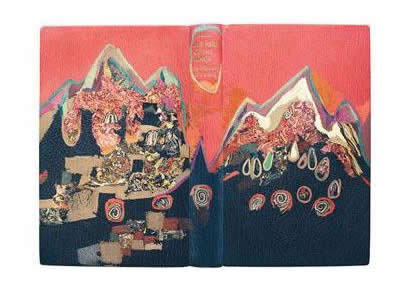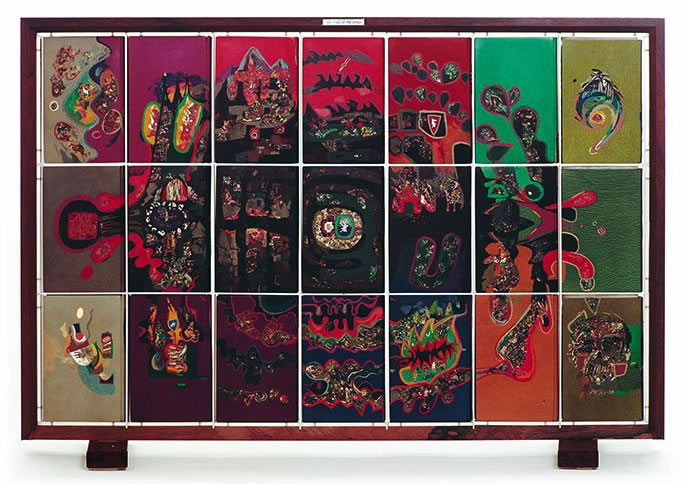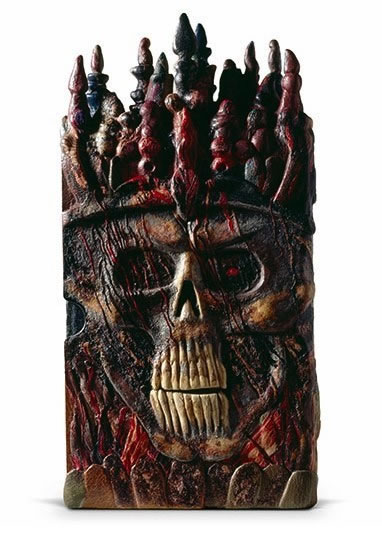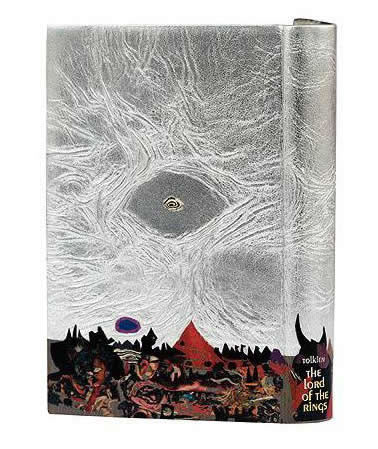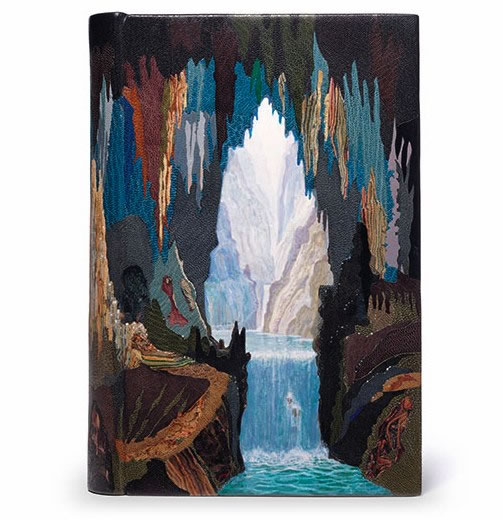The amazing art of bookbinding - The Lord of the Rings - Part 1 (24.01.11 by Pieter Collier) -
Comments
This week-end I was thinking about the Tolkien exhibition that my friend Johan Vanhecke organized in Antwerp in 1992. I recall that there was a copy on display of a bookbinding by Philip Smith. Back then I thought it looked great, but did not in the least understand the value, importance and beauty of the object. Since then I have seen many custom bookbindings, custom slipcases, rebound Lord of the Rings editions and have very much grown in admiring them. In general I do prefer a clean original copy of The Lord of the Rings over a fine binding, but sometimes the quality of the binding can be so high that I cannot but love and admire the craft and result - and then I don't mention yet the smell. Some signed books or association copies just are in such a poor state that a nice binding can give them back the looks they deserve - especially if no costs are spared to make the result match the value of the book. Next to rebound editions there is however one level higher up and this is what I want to talk about: the amazing art of bookbinding. Learning the craft of bookbinding is in itself a great challenge, but sometimes there are true artist among the binders and these elevate the craft to a true form of art. They don't just create fine bindings but actually make book art!
Over the next days I'll talk about the amazing art of bookbinding, in a series of articles where I will first look at The Lord of the Rings and show some amazing book art. After that I'll show amazing copies of The Hobbit and I will end the week with The Silmarillion and related books. In this first article in the series I am obliged to start with the best art binder in the world, Philip Smith.
He is one of today's most unusual and extraordinary bookbinders. Born in 1928, he combines unorthodox materials and approaches to his fine bookbindings, sometimes creating sculptural assemblages using multiple copies and volumes of books. His influence is far and wide: he's served as Past President of Designer Bookbinders (UK), written several important books and many articles on bookbinding, and lectured extensively around the world on bookbinding as an art form. He is most famous for his fine bindings of The Lord of the Rings and that is what we will be looking at in this first article.
The bookbindings by Philip Smith, the most beautiful copies of The Lord of the Rings in the world
When Philip Smith was asked to provide some bookbindings for a one-man exhibition at Ascona in Switzerland in 1970, he decided to create a unique centre-piece. Being a long time fan of The Lord of the Rings, Philip Smith felt that this complex psychological book could be the basis for a large art work - a Lord of the Rings book wall.
There was no prior example of a series of bindings where the design flowed across several covers and Philip Smith perceived that this concept could allow him freedom of expression and technique. He ordered six sets of unbound sheets of the 1968 edition from the publishers, George Allen & Unwin, and subsequently purchased the 1966 edition from a bookseller.
The bindings were subsequently exhibited at the Craftsman's Art Exhibition in May 1973. J.R.R. Tolkien visited the exhibition and saw the bindings and was very delighted. He commented to Philip Smith that at the age of eighty-one he could at last say what he liked and that indeed he liked Philips Smith's bindings very much. Tolkien even purchased a binding of The Lord of the Rings by Philip Smith at this exhibition and presented it as a gift to the Duke of Edinburgh. Philip Smith from his side stated he owes J.R.R. Tolkien an immense debt for the inspiration he gained from the reading of his works.
1) When the twenty-one volumes are in the display case you see one overall image of the lidless eye of Mordor. In the middle is the Tengwar incantation from the One Ring. The exaggerated and fluid shape of the eye reflects the multiplying evil of Mordor. At the opposite side of the wall you can see the ground plan of the city Minas Tirith.
2) Each book when opened forms its own integral image relating to the Lord of the Rings. The series of book images can be read from top left through to bottom right. Amongst others one can see the following scenes: Gandalf's arrival at Bilbo's front door, the fireworks at Bilbo's birthday party, the Council of Elrond, the Balrog and Gandalf falling into the chasm, the Forbidden Pool, Shelob's lair, the Circle of Isengard and the Tower of Saruman, the Battle of Helm's Deep, and the final eruption of Mount Doom.
3) When the books are placed next to each other on a conventional book shelf the lettering on the spine of each volume is at different vertical position. According to Philip Smith if staves are drawn at 45 mm intervals the basis of a musical sequence can be obtained.
The volumes set flat within the double-sided rosewood and perspex display case measures 800 by 1170 mm.
In July 2003 this amazing art work was sold by auction at Christies for 151,200 GBP.
Next to this large book-wall, Philip Smith later created a smaller one that consisted of 6 deluxe editions. In total he made at least 54 bindings for The Lord of the Rings and made many bindings for other books like The Hobbit, The annotated Hobbit and The Silmarillion. During the creation of these bindings Philip Smith not only changed the art of bookbinding completely, but also invented 'Maril,' marble-inlaid leathers that got their name from the 'Silmarils' from tolkien's Silmarillion. By mixing scraps and fragments of leather parings and compressing them, a block or thick tile is created. Parings from the surfaces can be taken at different angles and used to produce configurations and textures to build up images along with conventional parings for onlays or inlays. The only thing I can say is that I love 'Maril' and that it looks fantastic!
One of the finest book boxes created by British artist Philip Smith, holds a deluxe edition of The Lord of the Rings, probably an India paper edition by Allen & Unwin, which was published in 1969.
It shows the artists vision of tolkien's The Lord of the Rings. The skull represents the Ringwrailh King and the contorted upper spires his crown. The bookbinding is designed to work with a raking light to give deep relief to the modeling. The nine dead ringwraiths' headstones line the lower edge of the box.
The opposite side shows Galadriel with her mirror, this time the upper spires show the landscape of Lothlorien.
The book-box is made from binders board, balsa wood and with brass-reinforced epoxy-putty modeling. It is covered with goatskin and to get the right effect various parts of goatskin are used: strips, emulsified or individual flesh side and grain side parings, and maril.
The box has two compartments for the book and a map folder. The leather clasp is designed to match the images on both sides.
The sky is composed of puckered silver leather with the 'Eye of Sauron' on the lower cover. The landscape below is composed of maril and shows the erupting Mount Doom beneath the 'Eye,' the Two Towers and abstract representations of characters and creatures from the books.
On the spine is 'Tolkien' and 'The Lord of the Rings' lettered in silver and gilt. The book further has gilt edges, decorative front endpapers comprising the title in mirrored writing reminiscent of tolkien's own hand, printed grey on white with shadowed outline. The two folding maps are housed in a separate folder, covered in paper of the same design, but with the letters not mirrored and printed black on white.
This amazing The Lord of the Rings copy was sold by action at Christies in December 2002 for GBP 4,541.
This is the 51st binding of the book by Philip Smith.
The books is bound in scarf-joined black, blue and beige goatskins and shows multicolored onlays and maril. The hand-painted inset in acrylics (waxed) and washy acrylic hand-painted endpapers over maroon Ingres flyleaves make this copy a true piece of art.
Many of the books by Philip Smith were commissioned pieces and either represent a scene the buyer liked, or show a link to the profession of the owner (like a large eye for an eye-surgeon) or in fact show the feeling that the owner had while reading the Lord of the Rings. Overall these books can be called "true art" and I believe any Tolkien collector secretly hopes one day to treasure such a copy. Alas they are so expensive these days that we can only dream!
There are many more copies that I would wish to show, but who knows I'll be updating this article in the future and add some more. As for now I believe you have a good feeling how Lord of the Rings copies rebound by Philip Smith look like and so tomorrow we will have a look at some other fine bindings.
Spread the news about this J.R.R. Tolkien article:
